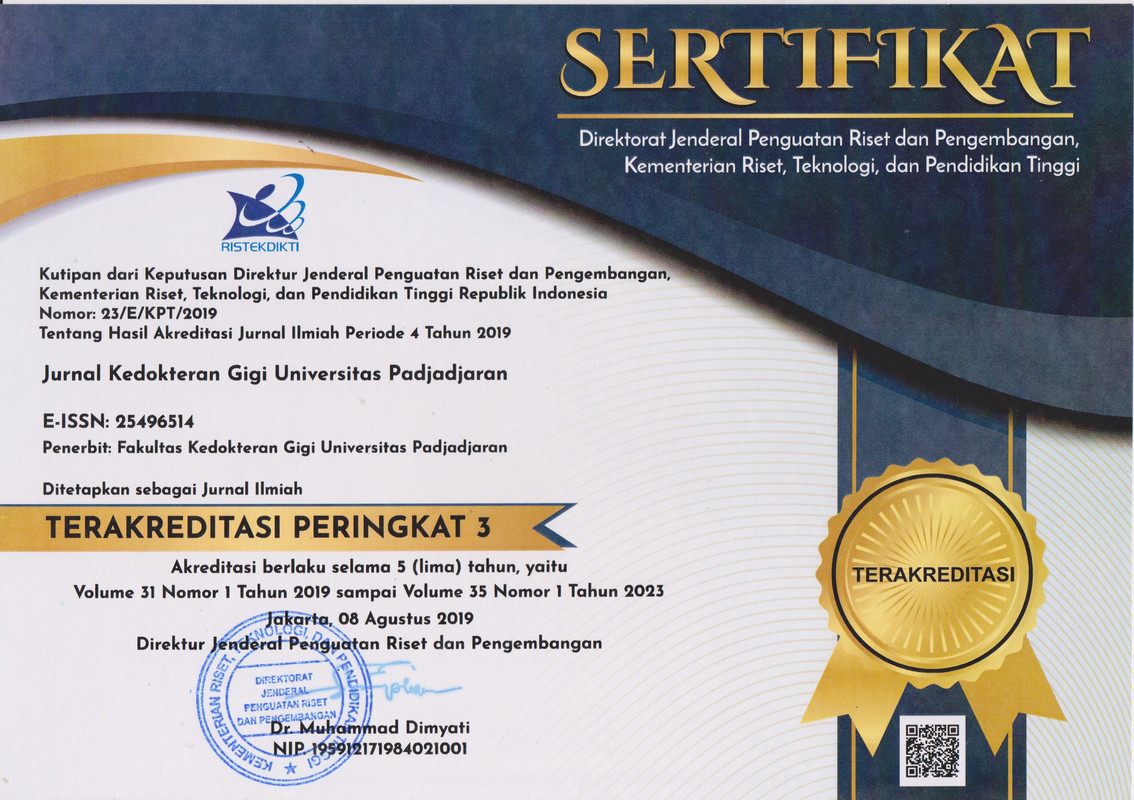Differences in denture brush fibers made of apus bamboo (Gigantochloa apus) and nylon based on the level of Streptococcus mutans contamination: an experimental study
Abstract
ABSTRACT
Introduction: Streptococcus mutans bacteria is one of the microorganisms that form plaque on the denture. Plaque can be cleaned using nylon denture brush fibers, which have no antibacterial effect and are at risk of becoming a medium for contamination. Nylon fibers can be replaced by natural fibers, namely apus bamboo (Gigantochloa apus). The purpose of the study was to analyze the difference between apus bamboo and nylon denture brush fibers based on the level of Streptococcus mutans contamination. Methods: The type of research was laboratory experimental with pre-test and post-test with control group design. Sampling using the unpaired numerical comparative test sample size formula. The treatment group with apus bamboo fibers was 10 samples while the control group with nylon fibers was 10 samples. Each sample was soaked for 3 minutes in a bacterial suspension, followed by dilution to 10-5, and counted by the total plate count (TPC) method. Variable measurements were taken before and after 24 hours of standing, then the amount of Streptococcus mutans contamination was compared between bamboo and nylon. Results: The mean number of Streptococcus mutans contamination after 24 hours of standing on the bamboo fibers was 7.6x106 and nylon fibers 1.7x105, then tested using the Mann-Whitney and obtained a value of p=0.009 (p<0.05). Conclusion: There is a difference between apus bamboo and nylon denture brush fibers based on the contamination level of Streptococcus mutans after standing for 24 hours.
Keywords:
brush fiber, dentures, bamboo apus, nylon, streptococcus mutans.
Perbedaan serat sikat gigi tiruan berbahan bambu apus (Gigantochloa apus) dan nilon berdasarkan tingkat kontaminasi bakteri Streptococcus mutans: eksperimental laboratoris
ABSTRAK
Pendahuluan: Bakteri Streptococcus mutans merupakan salah satu mikroorganisme pembentuk plak pada gigi tiruan. Plak umumnya dapat dibersihkan menggunakan serat sikat gigi tiruan berbahan nilon, yang tidak memiliki efek antibakteri dan beresiko menjadi media kontaminasi. Serat nilon pada sikat gigi tiruan dapat digantikan oleh serat alam, yaitu bambu apus (Gigantochloa apus). Tujuan dari penelitian adalah untuk menganalisis perbedaan antara serat sikat gigi tiruan bambu apus dan nilon berdasarkan tingkat kontaminasi bakteri Streptococcus mutans. Metode: Jenis penelitian yaitu eksperimental laboratorik dengan rancangan pre-test and post-test with control group design. Pengambilan sampel menggunakan rumus besar sampel uji komparatif numerik tidak berpasangan. Kelompok perlakuan dengan serat bambu apus sebanyak 10 sampel sedangkan kelompok kontrol dengan serat nilon sebanyak 10 sampel. Setiap sampel direndam selama 3 menit di dalam suspensi bakteri, dilanjutkan dengan pengenceran hingga 10-5, dan dihitung dengan metode total plate count (TPC). Pengukuran variabel dilakukan sebelum dan setelah didiamkan 24 jam, kemudian jumlah kontaminasi bakteri Streptococcus mutans dibandingkan antara serat bambu apus dan serat nilon. Hasil: Rerata jumlah kontaminasi bakteri Streptococcus mutans setelah didiamkan 24 jam pada serat bambu apus adalah 7.6x106 dan serat nilon 1.7x105, kemudian dilakukan pengujian menggunakan uji Mann-Whitney dan didapatkan nilai p=0,009 (p<0,05). Simpulan: Terdapat perbedaan antara serat sikat gigi tiruan bambu apus dan nilon berdasarkan tingkat kontaminasi bakteri Streptococcus mutans setelah didiamkan 24 jam.
Kata Kunci :
serat sikat gigi, gigi tiruan, bambu apus, nilon, streptococcus mutans
Keywords
Full Text:
PDFReferences
REFERENCES
Gabiec K, Bagińska J, Łaguna W, Rodakowska E, Kamińska I, Stachurska Z, et al. Factors associated with tooth loss in general population of bialystok, poland. Int J Environ Res Public Health. 2022 Feb 18;19(4):2369. https://doi.org/10.3390/ijerph19042369
Massie NSW, Wowor VNS, Tendean L. Kualitas hidup manusia lanjut usia pengguna gigi tiruan di Kecamatan Wanea. e-GIGI. 2016 Sep 20;4(2). https://doi.org/10.35790/eg.4.2.2016.13651
Setiadi Putri V, Setyawan H, Hestiningsih R, Udiono A. Hubungan perilaku pemeliharaan dengan kondisi gigi tiruan lepasan pada masyarakat di wilayah kerja puskesmas bandarharjo kota semarang. 2017;5(4):500-4. https://doi.org/10.14710/jkm.v5i4.18674
Riskesdas. Laporan nasional riskesdas 2018. 2019.
Adjani R, Sarwono AP. Tingkat pengetahuan masyarakat terhadap penggunaan gigi tiruan: kajian di usia 46-65 tahun. e-GiGi. 2023 Mar 9;11(2):183–8. https://doi.org/10.35790/eg.v11i2.45186
Nurma Himammi A, Tri Hartomo B. Ekstraksi gigi posterior dengan kondisi periodontitis kronis sebagai persiapan pembuatan gigi tiruan lengkap pada pasien diabetes mellitus. J Kes Gi. 2020;8(1):6–10. https://doi.org/10.31983/jkg.v8i1.6572
Naik R, Mujib BRA, Telagi N, Anil BS, Spoorthi BR. Contaminated tooth brushes–potential threat to oral and general health. J Family Med Prim Care. 2015;4(3):444. https://doi.org/10.4103/2249-4863.161350
Waruni KA. Akumulasi Streptococcus mutans pada basis gigi tiruan lepasan plat nilon termoplastik dan resin akrilik. Interdental J Ked Gi. 2017;13(2):28–31.
Nair V, Karibasappa G, Dodamani A, Prashanth V. Microbial contamination of removable dental prosthesis at different interval of usage. J Indian Prosthod Soc. 2016;16(4):346. https://doi.org/10.4103/0972-4052.176536
Chotimah C, Asian S, Fairuz A, Biba AT. Penyuluhan gigi tiruan pada lansia dan pencegahan denture stomatitis. Idea Pengabdian Masyarakat. 2022;2(2):75–8. https://doi.org/10.53690/ipm.v2i02.111
Zarb G, Hobkirk JA, Eckert SE, Jacob RF. Prosthodontic treatment for edentulous patients complete dentures and implant-supported prostheses. 13th ed. Fenton, Finer, Chang, Koka, editors. Elsevier; 2013.
Alfouzan AF, Alnouwaisar AN, Alazzam NF, Al-Otaibi HN, Labban N, Alswaidan MH, et al. Power brushing and chemical denture cleansers induced color changes of pre-polymerized cad/cam denture acrylic resins. Mater Res Express. 2021;8(8):1-10. https://doi.org/10.1088/2053-1591/ac1e47
Suparno O. Potensi dan masa depan serat alam indonesia sebagai bahan baku aneka industri. Jurnal Teknologi Industri Pertanian. 2020 Sep;221–7. https://doi.org/10.24961/j.tek.ind.pert.2020.30.2.221
Matayoshi S, Nomura R, Kitamura T, Okawa R, Nakano K. Inhibitory effect of brush monofilament containing surface pre-reacted glass-ionomer (s-prg) filler on Streptococcus mutans. Sci Rep. 2021 Jan 8;11(1):211. https://doi.org/10.1038/s41598-020-80646-x
Agarwal S, Chakraborty R, Modak J, Manohar B, Panigrahi K, Bhuvaneshwari S. Microbial contamination of brush heads: a comparative study between conventional plastic and bamboo brush – an in vitro pilot study. Advances in Human Biology. 2024;14(2):102–6. https://doi.org/10.4103/aihb.aihb_122_23
Yunela Panggabean W, Kamelia E, Nugroho C, Ambarwati T. Perilaku menyikat gigi dengan pasta gigi ekstrak siwak menggunakan teknik roll terhadap status kesehatan ginggiva pada remaja usia 13-15 tahun. J Oral Health Care. 2020;8(2):76–85. http://dx.doi.org/10.29238
Rohisa D. Desain motif batik cimahi sebagai wujud identitas budaya dalam kacamata antropologi. Brikolase : Jurnal Kajian Teori, Praktik dan Wacana Seni Budaya Rupa. 2022 Aug 19;14(1):1–13. https://doi.org/10.33153/brikolase.v14i1.4292
Ritonga MA, Navia ZI, Arico Z. Pemanfaatan tumbuhan bambu oleh masyarakat di kecamatan tenggulun kabupaten aceh tamiang. Biologica Samudra. 2020 Apr 28;2(1):10–9. https://doi.org/10.33059/jbs.v2i1.2232
Ramful R, Sunthar TPM, Kamei K, Pezzotti G. Investigating the antibacterial characteristics of japanese bamboo. Antibiotics (Basel) [Internet]. 2022 May 1 [cited 2024 Jul 14];11(5). https://doi.org/10.3390/antibiotics11050569
Raiyani C, Arora R, Bhayya D, Dogra S, Katageri A, Singh V. Assessment of microbial contamination on twice a day used brush head after 1-month and 3 months: an in vitro study. J Nat Sci Biol Med. 2015;6(3):44. https://doi.org/10.4103/0976-9668.166072
Julia Caroline, Miriam, Elisabeth, Tuomas, Roland, Clemens, et al. Influence of time, toothpaste and saliva in the retention of Streptococcus mutans and Streptococcus sanguini s on different brushes. Journal of Applied Oral Science. 2014 Jun;22(3):152–8. https://doi.org/10.1590/1678-775720130017
Ghoni Tjiptoningsih U, Permatasari FN. Pengaruh penyimpanan sikat gigi terhadap kontaminasi bakteri pada bulu sikat gigi. MDERJ. 2021;1(3):111–26. https://journal.moestopo.ac.id/index.php/mderj
Ishii Y, Suzuki I, Sakazume-Suzuki H, Kurakawa Y, Uchiyama T, Okada Y, et al. Low environmental impact bamboo brushes demonstrate comparable hygienic condition to that of plastic and biomass plastic brushes after use and storage. International Journal of Oral-Medical Sciences. 2023 Dec 9;22(1):23–34. https://doi.org/10.5466/ijoms.22.23
Khansaleta Wirgentia T, Awalia H. Pengaruh tempat penyimpanan sikat gigi terhadap jumlah bakteri kontaminan bulu sikat gigi. Jurnal Kesehatan Gigi dan Mulut (JKGM). 2019;1(2).
Wahyudi T, Kasipah C, Sugiyana D. Extraction of fiber from bamboo (Gigantochloa apus) for raw material of creative industry. Arena Tekstil. 2015 Aug;30:95–02. https://doi.org/10.31266/at.v30i2.1958
Yun J, Wei L, Li W, Gong D, Qin H, Feng X, et al. Isolating high antimicrobial ability lignin from bamboo kraft lignin by organosolv fractionation. Front Bioeng Biotechnol. 2021 May 26;9. https://doi.org/10.3389/fbioe.2021.683796
Alzagameem A, Klein SE, Bergs M, Do XT, Korte I, Dohlen S, et al. Antimicrobial activity of lignin and lignin-derived cellulose and chitosan composites against selected pathogenic and spoilage microorganisms. Polymers (Basel). 2019;11(4):670. https://doi.org/10.3390/polym11040670
Milano NT, Sari ESI. Gambaran perilaku dalam pemeliharaan gigi tiruan cekat (Kajian Pada RSGM-P FKG Universitas Trisakti). Jurnal Kedokteran Gigi Terpadu. 2023;5(1):184-7. https://doi.org/10.25105/jkgt.v5i1.17051
Nawawi AP, Rahaju A, Rivawati AP. Effects of Gigantochloa apus string bamboo fiber brushes on heat‐cured acrylic resin plate surface roughness. Int J Dent. 2025 Jan 22;2025(1). https://doi.org/10.25105/jkgt.v5i1.17051
Hunggurami E, Sir TMW, Lau MIKK. Pengujian kuat tekan dan kuat lentur material pengganti kayu dengan campuran serat nilon. J Tekn Sip. 2015;4(2):209-16. https://doi.org/10.35508/jts.4.2.209-216
Da Silva LAB, Nelson‐Filho P, Saravia ME, De Rossi A, Lucisano MP, Da Silva RAB. Mutans streptococci remained viable on brush bristles, in vivo, for 44 h. Int J Paediatr Dent. 2014 Sep 21;24(5):367–72. https://doi.org/10.1111/ipd.12079
Lee SY, Lee SY. Assessment of bacterial contamination of brushes using Illumina MiSeq. Oral Biology Research. 2019 Sep 30;43(3):180–8. https://doi.org/10.21851/obr.43.03.201909.180
R AA, Peedikayil FC, Chandru TP, Kottayi S, Aparna TP, Ismail S. Retention of Candida species on plastic and bamboo brushes. a comparative study. Wolters Kluwer - Medknow. 2021;27:73-76. https://doi.org/10.4103/dmr.dmr_19_21
Nayak L, Mishra SP. Prospect of bamboo as a renewable textile fiber, historical overview, labeling, controversies and regulation. Fashion and Textiles. 2016 Jan 26;3(1):2. https://doi.org/10.1186/s40691-015-0054-5
Venkatasubramani R, Kola NK, Srinivasan K, Shahanaaz S, Reddy V. Evaluation of microbial count between bamboo brush and plastic brush. Internasional Journal of Scientific Research [Internet]. 2021;10(05):71–3.https://doi.org/10.36106/ijsr
Saffarzadeh A, Khodarahmi N, Mohammadi M, Author C. Evaluation of the effect of ultra-soft brushes with different commercial brands on plaque and bleeding indices. J Dent Shiraz. 2021;22(1):53–9. https://doi.org/10.30476/dentjods.2020.83259.1044
DOI: https://doi.org/10.24198/jkg.v37i2.61197
Refbacks
- There are currently no refbacks.
Copyright (c) 2025 Jurnal Kedokteran Gigi Universitas Padjadjaran
INDEXING & PARTNERSHIP

Jurnal Kedokteran Gigi Universitas Padjadjaran dilisensikan di bawah Creative Commons Attribution 4.0 International License






.png)

















